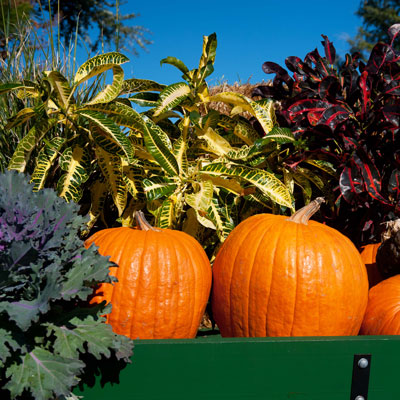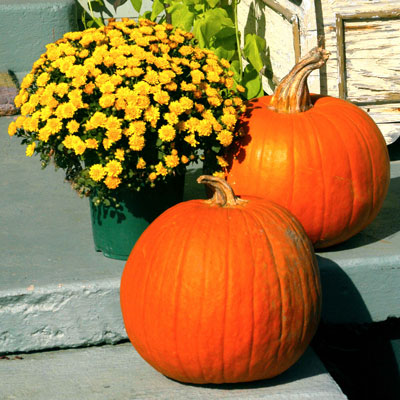Your Pumpkin’s Roots
Floydada, Texas, is in the High Plains of Texas, a region known as Llano Estacado. It’s an hour northeast of Lubbock, and it sits at 3,000 feet above sea level. Daytime high temperatures average low 90s in July, with nights falling into the mid-60s. Humidity is generally low, and that all makes for ideal growing conditions for pumpkins, squash and gourds. (Sounds pretty good to me, too!)

Photo: Right out of the crates, pumpkins are ready to sell.
3,000 people live in Floydada. They occupy 2 square miles of town. It’s not a big place. But it’s a giant pumpkin place. From two to three square miles of growing grounds, they produce and ship out upwards of 20 million pumpkins each year. That’s pumpkins, not pounds! That’s a lot of heavy lifting and a lot of big trucks doing heavy hauling.

Photo: Pumpkins, Indian corn, gourds and crotons dazzle fall arrangements.
Things to Know About Pumpkins
Many people make mistakes the first time that they try to grow pumpkins. Here are tips to help you avoid them.
• Start with fresh seed of specific varieties. Don’t save seeds from pumpkins you’ve bought. They’re hybrids. They don’t “come true” from seeds.
• Unless you’re gardening where night temperatures are cool through the summer, stick with small to mid-sized varieties.
• Plant at the right time. For Halloween pumpkins, sow the seeds in late June or early July. Most folks plant in the spring and wonder why they already have pumpkins by early summer. Sadly, there’s no good way to save ripe pumpkins for several months.
• Pumpkins require full sun. Their vines may grow well in shade, but they won’t bloom and set fruit.
• Plant in highly organic, well-draining soil.
• Know each variety’s mature plant size, and space plants accordingly. Crowded pumpkins won’t produce well.
• Keep the plants moist at all times.
• If you’re not seeing pumpkins developing, check to see if you have a good mix of male and female flowers. Male flowers will have straight stems. They will usually be visible a couple of weeks prior to female flowers (swollen primordial fruit visible within the stems) to ensure good pollination.
• If you have both male and female flowers, yet you’re still not seeing fruit, you may not have good bee activity to transfer the pollen. Strip off a few male flowers. Peel back their petals, and daub pollen onto the female flowers.
• Use insecticides labeled for garden insects to control squash bugs, stink bugs and other common pests of pumpkins and other cucurbits (melons, cucumbers, squash, etc.).
• Mulch the garden to slow growth of weeds, also to keep the developing fruit from making direct contact with the soil.
• Apply water-soluble, high-nitrogen fertilizer to keep the plants growing vigorously.

Photo: A 30-second DIY spot of landscaping color!
